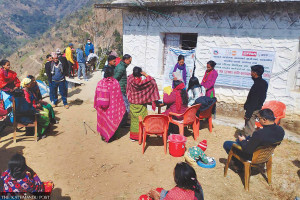 16.12°C Kathmandu
16.12°C KathmanduColumns
Time for fifth generation reforms
Fact-based periodisation is important to capture the long evolution of Nepal’s reform process.
Achyut Wagle
The Centre for Economic and Infrastructure Development Policy, under the Nepal Government’s only functional think tank, Policy Research Institute, has announced a research project: Second Generation of Reforms in Nepal for Structural Transformation. Former Prime Minister Baburam Bhattarai, in his keynote address at the academia-industry meet organised by Kathmandu University last week, begged to differ with those who see the impending reform to be just “second generation”. His conjecture was that it must be at least the third or fourth generation of economic reform in Nepal. In a write-up on economic reform suited to fiscal federalism, published in the magazine Sejon Smarika-2078, I had proposed that it would be appropriate for (then) ongoing reform to be viewed as the “fourth generation”.
Does it make any fundamental difference if we call it the second, third or fourth generation of reform? It may not, in terms of implementation or outcome. But the periodisation of economic or governance reforms initiated in different historical contexts, contemporary objectives and extent of coverage have their own significance. In Nepal, these endeavours have been implemented under strikingly different political dispensations with equally different economic objectives.
Therefore, fact-based periodisation is important to capture the actual evolution of Nepal’s reform process and correctly record it for future reference. This article contends that the economic and governance reform the country undertakes henceforth may be called the “fifth generation” of reform. Here is why.
Generations of reform
The first phase of economic reform was initiated in 1985, during the last years of absolute monarchy. The Panchayat government implemented the Economic Stabilisation Programme, with loan assistance from the World Bank as the Structural Adjustment Programme (SAP). “SAP-2” was implemented in 1989, with the support of the International Monetary Fund.
The government of the day had fallen into a no-option trap to initiate these reforms as the country’s debt had exceeded 40.5 percent of GDP at the end of the fiscal year, July 15, 1985, and debt servicing had become increasingly challenging. Private sector growth was constricted due to inadequate investible liquidity as the government could not carry out the capital expenditure. There were only four government-owned banks in operation with impending insolvency.
The first-generation reform (1986-1992) established the Credit Information Centre and made some amendments to the Nepal Rastra Bank Act (1956) to enhance the bank’s supervisory capacity. Further, two commercial banks with foreign investment, the Nepal Arab Bank Limited and the Nepal Indosuez Bank, were opened. The extent of the success of this generation of reform may be debated, but the SAP was undoubtedly a bold departure to economic liberalisation encompassing economic and financial sector reforms.
The second generation of comprehensive reforms started following the reinstatement of multiparty democracy in 1990 and new parliamentary elections in 1992. The elected government made extensive legal and institutional reforms: The enactment of the Industrial Enterprise Act, the Foreign Investment and Technology Transfer Act and the Labour Act, among others, in 1992, and the rapid privatisation of state-owned enterprises put Nepal on the path of economic liberalisation. These legal and structural reforms made private investment possible in many sectors, including education, health, air and road transport, hydropower, banks and financial institutions and property development.
The third generation of reform began in 2000, amid political turmoil at the height of the Maoist insurgency (1996-2006). In 1999, the World Bank and the International Monetary Fund conducted a study titled “Financial Sector Assessment of Nepal”. Based on this, the government prepared the Financial Sector Strategy Paper in November 2000. The strategy included legal reform of the financial sector, strengthening the supervision and regulation functions of the Nepal Rastra Bank, privatising government-owned banks, and establishing an Asset Management Company, among others. To implement these reforms, the World Bank provided financial assistance of $16 million in a mix of loans and grants. The government incorporated many of these agendas in its 10th Five-Year Plan (2002-07), designed as a poverty alleviation strategy. This phase of reform brought about tangible improvements, particularly in the financial sector’s systemic stability, governance and efficiency.
The reform process seems to have largely stalled after Nepal became a republic by abolishing the monarchy in 2008. Since then, economic reform does not seem to be the political priority of governments, mainly those headed by Communist parties. It appeared to have been mired in the ideological battle of “socialism” versus “globalism.” The ongoing phase of reform after 2010, which can be termed the fourth generation, is limited to “financial sector development strategy”. The pace of change is extremely tardy, with limited scope, though it has been implemented in two stages by the central bank, with the financial assistance of $100 million from the World Bank.
Future reforms
The next phase of reform, which can be safely called the fifth generation, has the twin responsibilities of completing the pending task of past reforms along with undertaking entirely new reform initiatives in congruence with the federal polity and the fiscal federal architecture as enshrined in the 2015 constitution.
The Sphinx-like enigma at the highest policy level regarding privatisation and uninfringed private property rights has impeded the reform process. Capital market reform, setting up an asset management company and extending monetary policy radar to government-controlled agencies like the Employment Provident Fund are key unfinished agendas. There is a need for a completely unconventional approach to private sector reform towards improving corporate governance practices on the one hand and ensuring a fair and competition-enhancing business climate through appropriate policies and institutional arrangements on the other.
The national reform endeavour must now make all seven components of fiscal federalism—revenue, grant, expenses, debt, royalty, economic efficiency and economic governance—an integral part of both public and private sector reforms. The new reforms at the core must embrace the liberal democratic values that enable sub-national governments to take loans, facilitate public procurement and contract systems and simultaneously set institutional accountability mechanisms to control corruption even at the local level.
The results of reforms are undoubtedly pivotal, but the significance of the right nomenclature for the “generation” of reform shouldn’t be overlooked as a nationally accepted consensus on it adds value to overall reform narratives.



















